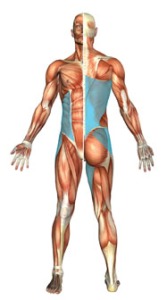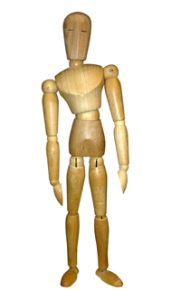What is the Trauma Reflex and why must we be able to recognize it?
In my previous two posts I described Green Light Reflex which acts on the muscles of the back of the body, and Red Light Reflex which acts on the muscles of the front of the body. In this post let’s look at the third brain reflex that we deal with within the context of Clinical Somatic Education, the Trauma Reflex. The Trauma Reflex acts on the muscles of one side of the body. It can be triggered by a fall, impact or collision. It is an automatic and protective brain reflex to guard against pain or injury.
Imagine the movement you would make to avoid being tickled at your lower right side ribs. You would twist slightly (or maybe a lot) your right hip would hike towards your right armpit and your right armpit would move towards your right hip, all the ribs on your right side tightening on one side to squirm, cringe or flinch away from the tickle. This is an example of the type of pattern of muscular contraction involved in the Trauma Reflex.
Trauma Reflex can develop through limping to protect an injured knee or ankle, through holding a child on one hip for long periods, by slipping off a kerb or step or even through one sided surgery, (ie appendicitis, mastectomy). The illustration below indicates the main muscles involved. One half of the diagram shows the front of the body, the other the back of the body. The main muscles involved are the rotators of the spine and torso, the latissimus dorsi, the obliques, the quadratus lumborum, the abductors of the hip on the affected side, and the adductors of the thigh on the other side.
Whilst Green Light Reflex and Red Light Reflex are best viewed side on, Trauma Reflex is best viewed head on. Lets look at the wooden mannequinn again so we can get an idea of how Trauma Reflex can look. I say can look, because the Trauma Reflex has the most variability in how it presents, it can be either very pronounced or very subtle and the degree of spinal rotation and/or lateral flexion (side bending) is rarely the same from one case to another.
So in this case, the wooden man is displaying a right side trauma reflex. The right side shoulder is pulled down and back and the right side hip is hiked up slightly. You will notice that the head is tilted to the left slightly to compensate, this is an attempt by the brain to keep the head balanced in gravity. Because this reflex creates more tension on one side of the body it throws us off balance. We will walk with more weight on one side. And in the same way the tyres on your car will wear down at different rates if they are not balanced, your joints will accumulate more wear and tear on one side if you are not in balance.
Habituation of the Trauma Reflex can lead to sciatica, back, hip, knee, ankle pain, leg length discrepancy and plantarfasciitis among other issues.
Summary:
- The Trauma Reflex is an automatic and protective brain reflex.
- It can be caused by a slip, fall, collision or one sided surgery.
- It causes the muscles of twisting and side bending to tighten on one side of the body.
- It distorts our sense of balance and our natural gait/walking pattern.
- It can lead to one sided pain/conditions such as sciatica, plantarfaciitis, back, hip, neck, knee, ankle pain.
You can start learning how to regain control of the Trauma Reflex right now by practicing the Somatic Movements that address all the muscles of the sides of the body. Below is a Somatic Movement playlist that does just that. Try these movements and enjoy your new found sense of balance and groundedness.
As always, thanks for reading.


